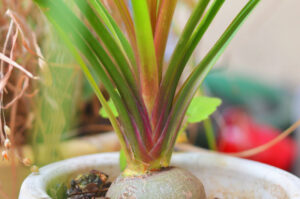Growing Pothos on moss poles- Everything you need to Know
Moss poles are the most simple and easy way to develop interest for people to grow plants upwards instead of downwards. It is a good idea for a Pothos plant, Swiss cheese plants, and most philodendrons. But where to buy such a moss pole that can utilize it for the better growth of Pothos? How to make it? What is primary care? Here is a complete guide to help you.
Moss poles:
So before going into the depth of Growing Pothos in moss poles, you need to have a clear idea of moss poles and Pothos. So, what are moss Poles? Have you heard it the first time?
Well. Moss poles are also moss sticks, bamboo stakes, plant supports, climbing poles, moss totems, etc. The primary purpose of the moss pole is to be used as an object standing vertically with moss or a natural Coco coir fiber. It is used to emulate the natural growing environment of a climbing vine and provide it with micronutrients and water via aerial roots.
Pothos:
Pothos are grown in hanging pots. I bet you that many of the houseplants are unaware that growing Pothos upwards makes them produce lusher, larger plants, making them healthier and more attractive.

You will be surprised to know that Pothos is also called Devil’s ivy or botanically called ‘Epipremnum aureum.’ They are believed to be native to tropical regions but originated in Southeast Asia. In the race of time, they become invasive, wild, and conquerors in Florida. The natives of Florida began using them as decorative foliage but adapted to thrive in the state’s warm, humid climate.
According to some botanists, the Pothos can be classified into 9 types; some examples are Neon Pothos, Marble Queen Pothos, Golden Pothos (money plant; devil’s ivy), Silver Pothos (satin Pothos), Manjula Pothos, Jessenia Pothos.
Out of 9 Pothos, three are well-known to everyone: marble queen, neon, and golden Pothos. Pothos are pretty identical to each other that’s why they are often mistaken as from one variety to another.
Pothos are often used as aerial roots to anchor onto trees, aerate the plant and hydrate themselves. Often used as beautiful draping vines, they are easy to climb, which makes them the best of the best option for a moss pole.
Wild Vs. Domestic Pothos:
The Pothos that grows in a lush jungle environment originated in that forest. They are often grown on trees, and they climb up houses in suburban areas. The wild variety generally grows up to 40’tall and leaves up to 3′ wide! Domestically, they are grown in hanging baskets. These Pothoses rarely get leaves larger than palm-sized.
Where to buy a Moss pole for Pothos?
We all are nature lovers, and to enhance the aesthetic look of our home and surrounding moss, poles have become a household name in every house. The especially post-pandemic effect turned them into indoor gardeners, and thus, the demand and popularity of the Pothos Moss pole have increased immensely.
You can buy moss poles from your local garden centers or, you can order them online with various options and features. These moss totems are relatively inexpensive, ranging from $10 – 30, and the price somewhat depends on size and quantity. The climbing pole generally has inner support – often a PVC pipe or Wooden slab surrounded by a sturdy bamboo and then covered in coir fiber or sphagnum peat moss.
Does Pothos Need a moss pole:
While the genus Pothos doesn’t need a moss pole, having one can help support it, access to water, and larger leaves. Without a moss pole , these vining plants will grow horizontally and have slightly smaller leaves. Neither option is superior and depends more on personal aesthetics.
Benefits Of Growing Pothos on moss pole:
- Moss poles encourage Pothos to grow upwards instead of outwards or downwards.
- The most obvious reason for using a moss pole is that they support climbing, and hence the Pothos can grow like other plants in the wild.
- It helps in providing a natural environment for the Pothos to grow.
- One of the key benefits of the moss stick (moss pole) is that the moss, made from coconut fiber, retains moisture. This helps to aid the Pothos in a few ways, such as giving them access to water when needed with the help of their aerial roots.
- When growing in the natural environment, these roots help vining plants scale trees to reach the light at the top of dense canopies.
- Using moss poles helps stimulate more giant leaves in the plants. The aerial roots of plants help them cling to whatever it is growing up, but they also function much like their roots in the soil. Over time, contact with a moss pole can trigger the development of larger leaves. So, the Pothos’ aerial roots increase the potential for a healthier plant.
- The aerial roots of moss poles also play an essential role for plants growing in waterlogged areas, and they function as aerators for plants when they are soaked in water.
How to attach Pothos to a moss pole?
You need to insert the pole into the soil a few inches, at least three inches away from the stem, to protect the roots. Wrap your Pothos vines around and up the moss pole attaching them to the plant.
Training a Pothos to be on a moss plant.
After getting the idea that Pothos can be grown on moss poles, what comes next? Is it easy to develop them? Who to train them to be on moss plant?
We all know that Neo Pothos, Marble Queen Pothos, Golden Pothos, silver Pothos, etc., are naturally trailing, vining plants that look great and grow healthier on vertical support.
The training of Pothos to grow on a moss pole is quite simple; you only need to install a pot and start attaching the plant to the pole. The rest of the procedure will be given by Pothos during the time. Here is the process we need to understand for your Pothos’ healthy growth carefully.
1. Create or buy Moss Pole:
You have two options either you buy a moss pole, or you can create it. You can buy a commercially made moss pole that will convert your Pothos into a beautiful climbing vine. The other option is DIY. If you believe in yourself and are creative enough, you can go for creating a moss pole. Creating a moss pole is a fairly straightforward one to tackle.
2. Soak the Moss Pole:
The most important thing that moss always need is moisture. It would help if you soaked your moss pole to make it nice and wet for your plant. They prefer this as it mimics the moist trees in their jungle home.
3. Install the Moss pole in your pot:
So, after soaking the moss pole, you need to install the Moss pole in your Pothos pot. If you are initially going for small Pothos, pile the supports for the moss pole in the dirt. You need to remember that the roots of the plants should not be injured.
Installing a moss pole will be quite cumbersome and tedious if you are directly going for large Pothos plants, which will take a bit longer. You need to pay attention when the moss pole is inserted.
Sometimes it is too difficult to find space to insert moss poles, and it is suggested to repot your plant and arrange it in such a way that it completely fits into the pot with the plant without causing any injury to plants and their roots.
4. Proper Tying of your Pothos to the moss pole:
After successfully installing the moss pole, you have to attach the plant to the moss pole so that it can climb and act as a climber. The aerial roots of Pothos will help to cling to moss poles, but till then, you must ensure that a sound support system is provided to the Pothos.
The following items will act well: garden twine, Velcro strips, or floral pins.
Wrap the longest vine around the pole and support it with twine or another support. You need to continue this procedure until the next largest and so on until the whole plant is wrapped around a moss pole. If your vines are too short, just leave them to hang out of the pot, and eventually, they will grow upwards.
5. Keep Damp!
Keeping the moss pole moist is the most crucial part of this procedure. You can make the pole damp by spraying it with a water bottle every few days.
6. Monitoring:
You need to adjust your Pothos as it climbs the moss pole. The pothos grow very fast, and the new growth may need to be adjusted as the plants get bigger and start attaching themselves to moss poles without extra help.
Making your moss pole:
Commercial moss poles are available from an online garden center or local department store. If you believe in sole gardening and creativity, you can go for your moss pole for your Pothos plant.
You need to follow a straightforward DIY project; it takes only a few seconds to find materials. You can get most of the supplies from your local hardware store or building supply center.
- You can also order them online. It would help if you had a wooden dowel or stake or a PVC pipe, and the pipe should be taller than the plant
- You need sphagnum peat moss or Coco fiber sheets
- Waterproof glue
- Twine
Making a DIY moss pole for your Pothos is not too difficult. If you use the suitable material, your Pothos climbing pole will be made in no time so that you can insert it in your post.
- Glue the first layer of your sheet of moss or coconut fiber to a wooden dowel.
- Wrap the sheet by layer around the pole until it becomes an inch thick.
- Wrap the twine around the moss pole in a spiral pattern to help it to secure the pole
- Be sure that you leave enough space at the base of the moss pole so that you can insert it into the dirt in the pot.
Conclusion:
Moss poles or moss totems are the perfect solution for indoor living and Pothos varieties.
If you don’t find any reason to purchase it online, you may go for any DIY project through the details provided above. They strengthen the Pothos, stimulate their natural habitat, develop larger leaves and enhance aesthetic beauty to growers’ love.






